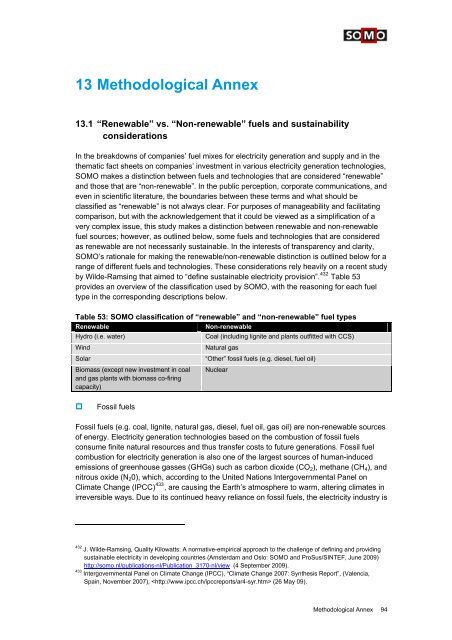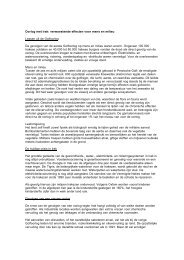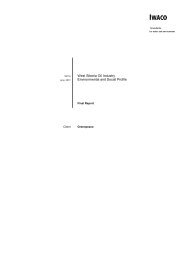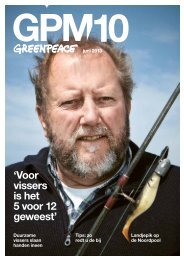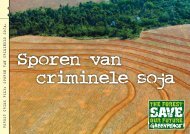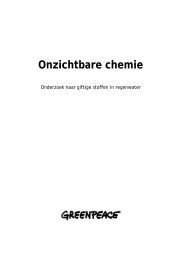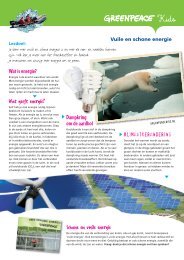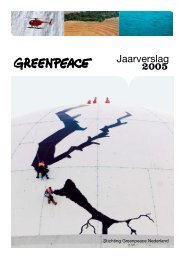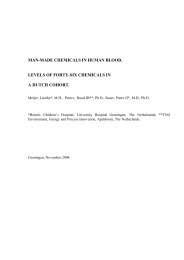Sustainability in the Dutch Power Sector - Greenpeace Nederland
Sustainability in the Dutch Power Sector - Greenpeace Nederland
Sustainability in the Dutch Power Sector - Greenpeace Nederland
Create successful ePaper yourself
Turn your PDF publications into a flip-book with our unique Google optimized e-Paper software.
13 Methodological Annex<br />
13.1 “Renewable” vs. “Non-renewable” fuels and susta<strong>in</strong>ability<br />
considerations<br />
In <strong>the</strong> breakdowns of companies’ fuel mixes for electricity generation and supply and <strong>in</strong> <strong>the</strong><br />
<strong>the</strong>matic fact sheets on companies’ <strong>in</strong>vestment <strong>in</strong> various electricity generation technologies,<br />
SOMO makes a dist<strong>in</strong>ction between fuels and technologies that are considered “renewable”<br />
and those that are “non-renewable”. In <strong>the</strong> public perception, corporate communications, and<br />
even <strong>in</strong> scientific literature, <strong>the</strong> boundaries between <strong>the</strong>se terms and what should be<br />
classified as “renewable” is not always clear. For purposes of manageability and facilitat<strong>in</strong>g<br />
comparison, but with <strong>the</strong> acknowledgement that it could be viewed as a simplification of a<br />
very complex issue, this study makes a dist<strong>in</strong>ction between renewable and non-renewable<br />
fuel sources; however, as outl<strong>in</strong>ed below, some fuels and technologies that are considered<br />
as renewable are not necessarily susta<strong>in</strong>able. In <strong>the</strong> <strong>in</strong>terests of transparency and clarity,<br />
SOMO’s rationale for mak<strong>in</strong>g <strong>the</strong> renewable/non-renewable dist<strong>in</strong>ction is outl<strong>in</strong>ed below for a<br />
range of different fuels and technologies. These considerations rely heavily on a recent study<br />
by Wilde-Rams<strong>in</strong>g that aimed to “def<strong>in</strong>e susta<strong>in</strong>able electricity provision”. 432 Table 53<br />
provides an overview of <strong>the</strong> classification used by SOMO, with <strong>the</strong> reason<strong>in</strong>g for each fuel<br />
type <strong>in</strong> <strong>the</strong> correspond<strong>in</strong>g descriptions below.<br />
Table 53: SOMO classification of “renewable” and “non-renewable” fuel types<br />
Renewable<br />
Non-renewable<br />
Hydro (i.e. water)<br />
Coal (<strong>in</strong>clud<strong>in</strong>g lignite and plants outfitted with CCS)<br />
W<strong>in</strong>d<br />
Natural gas<br />
Solar<br />
“O<strong>the</strong>r” fossil fuels (e.g. diesel, fuel oil)<br />
Biomass (except new <strong>in</strong>vestment <strong>in</strong> coal Nuclear<br />
and gas plants with biomass co-fir<strong>in</strong>g<br />
capacity)<br />
<br />
Fossil fuels<br />
Fossil fuels (e.g. coal, lignite, natural gas, diesel, fuel oil, gas oil) are non-renewable sources<br />
of energy. Electricity generation technologies based on <strong>the</strong> combustion of fossil fuels<br />
consume f<strong>in</strong>ite natural resources and thus transfer costs to future generations. Fossil fuel<br />
combustion for electricity generation is also one of <strong>the</strong> largest sources of human-<strong>in</strong>duced<br />
emissions of greenhouse gasses (GHGs) such as carbon dioxide (CO 2 ), methane (CH 4 ), and<br />
nitrous oxide (N 2 0), which, accord<strong>in</strong>g to <strong>the</strong> United Nations Intergovernmental Panel on<br />
Climate Change (IPCC) 433 , are caus<strong>in</strong>g <strong>the</strong> Earth’s atmosphere to warm, alter<strong>in</strong>g climates <strong>in</strong><br />
irreversible ways. Due to its cont<strong>in</strong>ued heavy reliance on fossil fuels, <strong>the</strong> electricity <strong>in</strong>dustry is<br />
432<br />
J. Wilde-Rams<strong>in</strong>g, Quality Kilowatts: A normative-empirical approach to <strong>the</strong> challenge of def<strong>in</strong><strong>in</strong>g and provid<strong>in</strong>g<br />
susta<strong>in</strong>able electricity <strong>in</strong> develop<strong>in</strong>g countries (Amsterdam and Oslo: SOMO and ProSus/SINTEF, June 2009)<br />
http://somo.nl/publications-nl/Publication_3170-nl/view (4 September 2009).<br />
433<br />
Intergovernmental Panel on Climate Change (IPCC), “Climate Change 2007: Syn<strong>the</strong>sis Report”, (Valencia,<br />
Spa<strong>in</strong>, November 2007), (26 May 09).<br />
Methodological Annex 94


